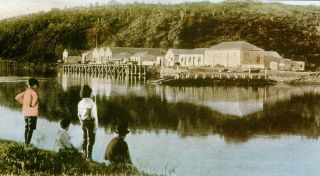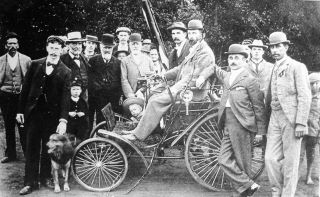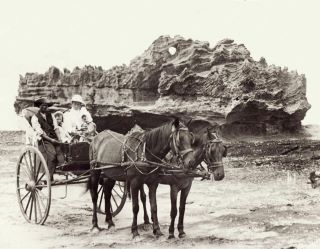The first people to inhabit the Eastern Cape were the KoiSan. The first explorer to land in the area was Portuguese explorer, Bartholomew Diaz who erected a cross at Kwaaihoek in 1488 whilst searching for a trading route to the East. In 1652, the Dutch East India Company established a trading station in the Cape, and began trading with the Koisan. Land ownership issues arose In 1779, and a series of bloody Frontier wars lasting 100 years between the Xhosa moving South into what is now known as the Eastern Cape, and the Dutch / British who were moving up from the Cape of Good Hope arose. In 1795, the British seized ownership of the Cape Colony.
Between 1803 – 1915 the war between Britain and France almost bankrupted Britain, and as a way of easing the financial burden of the British Empire, as well as a means of providing a barrier between the fighting in Southern Africa, the government offered land to Settlers in various colonies. In 1820, the first 4,000 British Settlers arrived in the Cape and were transported by Ox Wagon to Bathurst in the Eastern Cape where they were allocated land. The reality was that the Settlers soon found themselves in the middle of a struggle between Xhosa and British Soldiers and had to cope with drought, floods, crop failure and cattle raids with no support from the British, and all this, in the midst of the bloody Frontier Wars. A number of well-preserved buildings and monuments exist, mainly in Port Alfred and Bathurst, testament to the early years of the 1820 Settlers.
PORT ALFRED : One of the many difficulties faced by the 1820 Settlers was accessibility to the outside world. In 1821, the first ship entered the Kowie River, and the settlement of Port Alfred was born. (The town was originally named Port Francis, and endured several name changes over the years, finally being named Port Alfred in honour of Prince Albert who was visiting the colony at the time).
Wharf Street, the first commercial street in Port Alfred dating back to 1821, now a tourist hub, still has beautifully preserved buildings dating back to that time. Back in 1841, the potential of the river mouth as a port was realized, and in 1843 work commenced on the west and east piers at the new mouth of the Kowie River. From 1863 up to 100 vessels called in annuall, but sadly, the harbour fell into disuse in the 1890’s when the railway line was established between Port Alfred and Grahamstown. The construction of the line was part of the massive expansion of the Cape Colony’s railway system. The steam engines “Kowie” and “Port Alfrerd” were imported in 1882. The Kowie Museum, now housed in the old Railway Station Building in Port Alfred has a magnificent display on the Railway system.
The Port Alfred Hospital shows little signs of its original purpose, being the largest mental institution in the district by 1841. The caves behind the hospital grounds show evidence showing of convicts, constructing the piers, were housed behind unstable dynamite stores.
For 42 Years, the two halves of the town were linked by a pontoon. Then, in 1906, the foundation stone for the Putt Bridge linking East and West was laid. The original bridge was demolished and a new bridge constructed in 1989, allowing for 2 lanes of traffic. The famous Nico Malan Bridge spanning the Kowie River on the picturesque R-72 route was constructed in1970.
In 1907 friends W Stow, V Vroom, G Holloway and Dr Jones Phillipson chipped in twenty pounds each and established what is now known as the Royal Port Alfred Golf Club, one of only 5 “Royals” in Africa.
With the outbreak of WW11, the R.A.F. Airforce Base home to 43 Squadron was completed in 1942. Today this facility has grown into 43 Air School, an internationally acclaimed flying school.
The Sarel Hayward Dam was constructed in1986 to alleviate the fresh water problems, but as the town has grown more solutions have needed to be sought to meet the demands of the growing community. In 1989 the scenic and iconic Royal Alfred Marina and small boat harbour was built by visionary, Justin de Wet Steyn.
There is an excellent Heritage Map with detailed information and a self-guided tour of historical sites available from the Tourism Office or Download a copy.
BATHURST : The little hamlet of Bathurst, named after Lord Bathurst is an eclectic mix of old and new and has excellent and well-preserved buildings and monuments dating back to the early 1820’s, including the famous Pig and Whistle, a national monument built in 1831. The Wesleyan and St John’s church both served as sanctuaries and forts during the Frontier Wars. In 1870, farmer Charles Purdon planted a few pineapple tops, and today Bathurst is credited with being the pineapple capital of South Africa. No visit to Bathurst is complete without a visit to the Biggest pineapple in the World! Download a copy of a self guided tour of Bathurst.
MUSEUMS
There are four museums, click on the link below for details:
Albany Vintage Car Museum
ART GALLERIES
There are a number of spectacular Art Galleries on the Sunshine Coast. Numerous award winning artists reside in the little hamlets along this stretch of coastline. Some must visits are:
| Port Alfred | Bob MacKenzie Gallery, Wharf Street – Tel: |
| Maison Decor, Van der Riet Street – Tel: | |
| Richard Hammond Gallery, Tern Street – Tel | |
| Bathurst | The Workshop, Nico Malan Drive – Tel: |
| Just off Centre Gallery, Nico Malan Drive – Tel: | |
| Richard Pullen Ceramic Studio, Nico Malan Drive – Tel: | |
| The Corner Gallery, Nico Malan Drive – Tel: | |
| Alexandria | Maureen Quinn Art Gallery – Tel: |
| Kenton-on-Sea | Tess Lovemore Gallery |
| Rose Deary Gallery | |
| Voila | |





